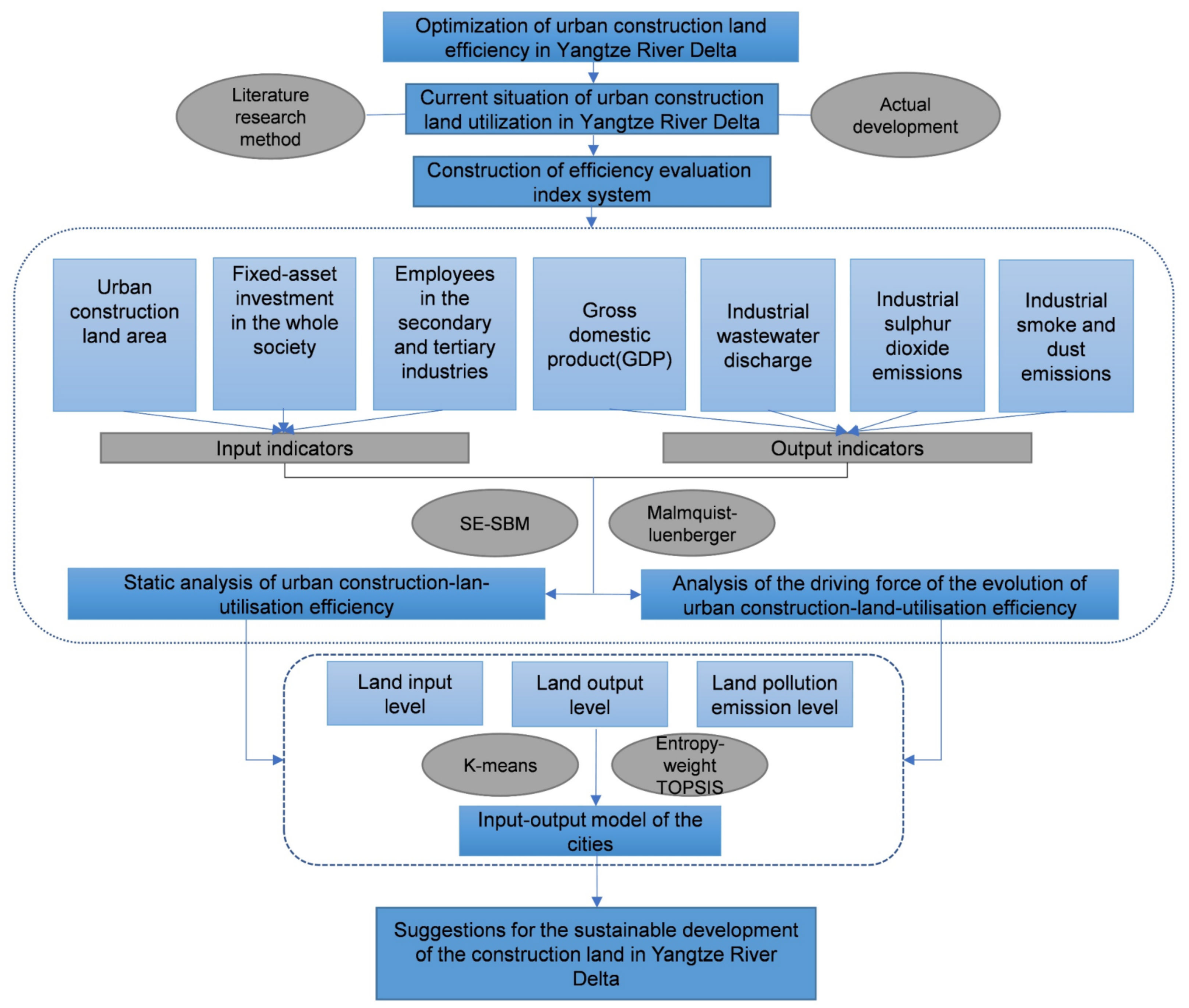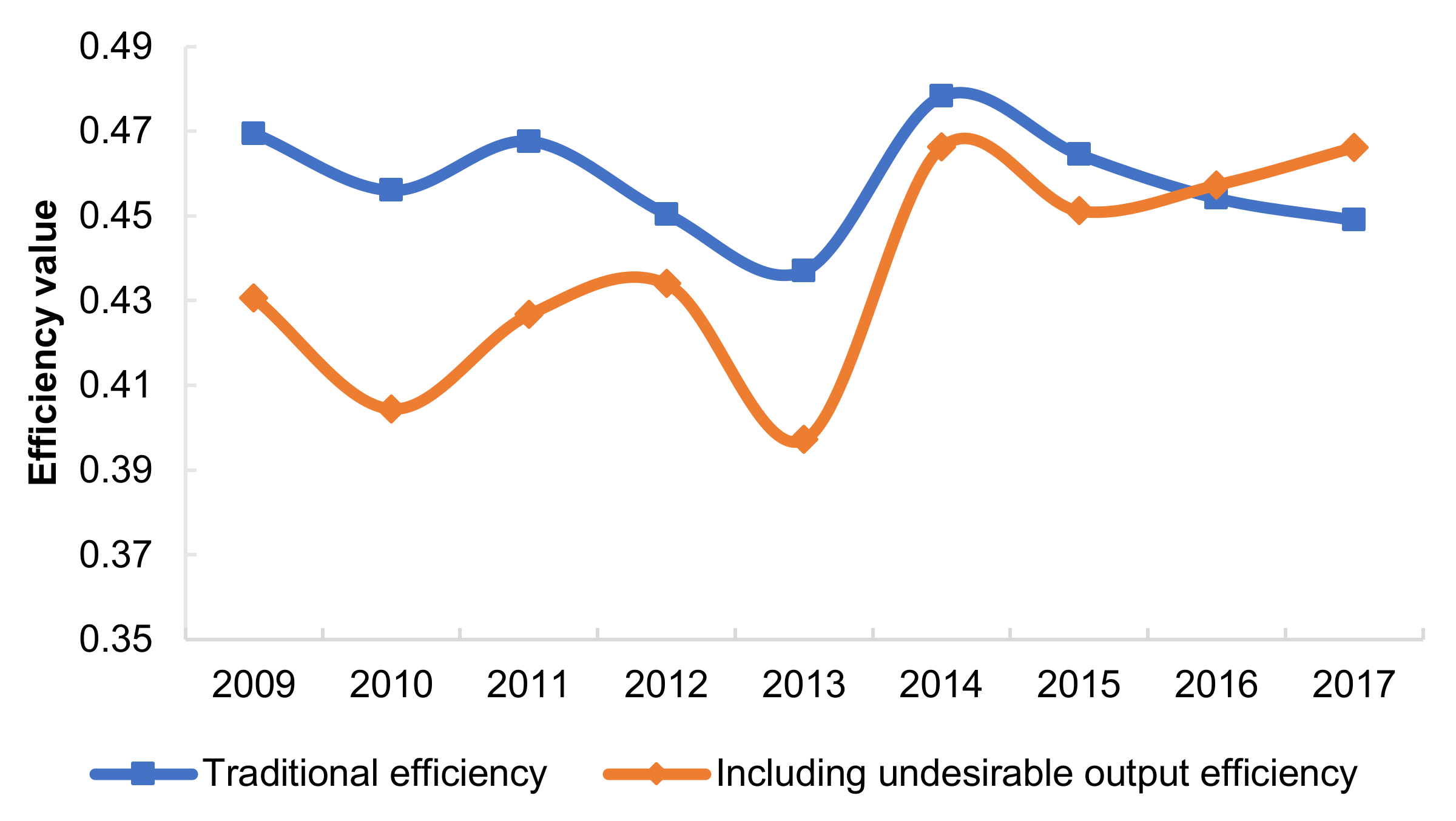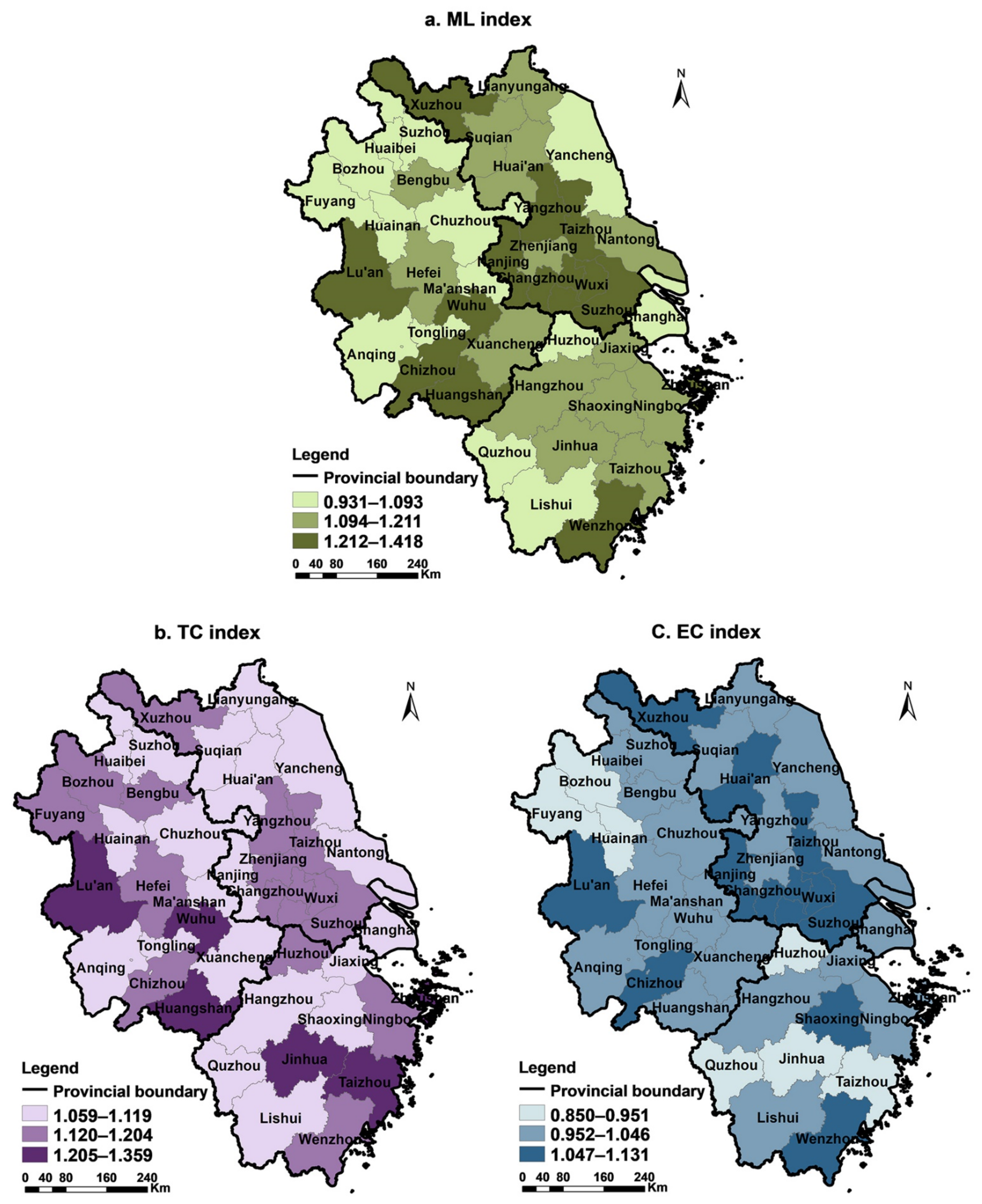Assessing Efficiency of Urban Land Utilisation under Environmental Constraints in Yangtze River Delta, China
Abstract
:1. Introduction
2. Data Sources and Research Methods
2.1. Overview of the Study Area
2.2. Data Source
2.3. Research Methods
2.3.1. The Research Design of the Paper
2.3.2. Construction of the Evaluation Index System
2.3.3. SE-SBM with Undesirable Output Model
2.3.4. Malmquist–Luenberger Model
2.3.5. Entropy-Weight TOPSIS Model
3. Results
3.1. Static Analysis of Urban Construction Land-Utilisation Efficiency
3.2. Analysis of the Driving Force of the Evolution of Urban Construction Land-Utilisation Efficiency
3.3. Correlation Analysis of Urban Construction Land-Utilisation Efficiency and Factor Inputs and Outputs
4. Discussion
5. Conclusions
Author Contributions
Funding
Institutional Review Board Statement
Informed Consent Statement
Data Availability Statement
Conflicts of Interest
References
- Chen, Y.; Chen, Z.; Xu, G.; Tian, Z. Built-up land efficiency in urban China: Insights from the General Land Use Plan (2006–2020). Habitat Int. 2016, 51, 31–38. [Google Scholar] [CrossRef]
- Yao, Q.; Shu, B.; Yong, X. Comprehensive evaluation and influencing factors of urban land utilization total factor productivity in Huaihai economic zone. Resour. Environ. Yangtze Basin 2019, 28, 1823–1832. [Google Scholar]
- Koroso, N.H.; Zevenbergen, J.A.; Lengoiboni, M. Urban land use efficiency in Ethiopia: An assessment of urban land use sustainability in Addis Ababa. Land Use Policy 2020, 99, 105081. [Google Scholar] [CrossRef]
- Yan, S.; Peng, J.; Wu, Q. Exploring the non-linear effects of city size on urban industrial land use efficiency: A spatial econometric analysis of cities in eastern China. Land Use Policy 2020, 99, 104944. [Google Scholar] [CrossRef]
- Du, J.; Thill, J.-C.; Peiser, R.B. Land pricing and its impact on land use efficiency in post-land-reform China: A case study of Beijing. Cities 2016, 50, 68–74. [Google Scholar] [CrossRef]
- Han, H.; Zhang, X. Static and dynamic cultivated land use efficiency in China: A minimum distance to strong efficient frontier approach. J. Clean. Prod. 2020, 246, 119002. [Google Scholar] [CrossRef]
- Cao, X.; Liu, Y.; Li, T.; Liao, W. Analysis of Spatial Pattern Evolution and Influencing Factors of Regional Land Use Efficiency in China Based on ESDA-GWR. Sci. Rep. 2019, 9, 520. [Google Scholar] [CrossRef]
- Jiang, H. Spatial–temporal differences of industrial land use efficiency and its influencing factors for China’s central region: Analyzed by SBM model. Environ. Technol. Innov. 2021, 22, 101489. [Google Scholar] [CrossRef]
- Zhang, L.; Zhang, L.; Xu, Y.; Zhou, P.; Yeh, C.-H. Evaluating urban land use efficiency with interacting criteria: An empirical study of cities in Jiangsu China. Land Use Policy 2020, 90, 104292. [Google Scholar] [CrossRef]
- Gao, X.; Zhang, A.; Sun, Z. How regional economic integration influence on urban land use efficiency? A case study of Wuhan metropolitan area, China. Land Use Policy 2020, 90, 104329. [Google Scholar] [CrossRef]
- Zhu, X.; Zhang, P.; Wei, Y.; Li, Y.; Zhao, H. Measuring the efficiency and driving factors of urban land use based on the DEA method and the PLS-SEM model—A case study of 35 large and medium-sized cities in China. Sustain. Cities Soc. 2019, 50, 101646. [Google Scholar] [CrossRef]
- Zhu, X.; Li, Y.; Zhang, P.; Wei, Y.; Zheng, X.; Xie, L. Temporal–spatial characteristics of urban land use efficiency of China’s 35mega cities based on DEA: Decomposing technology and scale efficiency. Land Use Policy 2019, 88, 104083. [Google Scholar] [CrossRef]
- Ding, T.; Yang, J.; Wu, H.; Liang, L. Land use efficiency and technology gaps of urban agglomerations in China: An extended non-radial meta-frontier approach. Socio-Econ. Plan. Sci. 2021, 101090. [Google Scholar] [CrossRef]
- Xie, H.; Chen, Q.; Lu, F.; Wu, Q.; Wang, W. Spatial-temporal disparities, saving potential and influential factors of industrial land use efficiency: A case study in urban agglomeration in the middle reaches of the Yangtze River. Land Use Policy 2018, 75, 518–529. [Google Scholar] [CrossRef]
- Liu, J.; Jin, X.; Xu, W.; Gu, Z.; Yang, X.; Ren, J.; Fan, Y.; Zhou, Y. A new framework of land use efficiency for the coordination among food, economy and ecology in regional development. Sci. Total Environ. 2020, 710, 135670. [Google Scholar] [CrossRef]
- Wu, C.; Wei, Y.D.; Huang, X.; Chen, B. Economic transition, spatial development and urban land use efficiency in the Yangtze River Delta, China. Habitat Int. 2017, 63, 67–78. [Google Scholar] [CrossRef]
- Chen, W.; Chen, W.; Ning, S.; Liu, E.-n.; Zhou, X.; Wang, Y.; Zhao, M. Exploring the industrial land use efficiency of China’s resource-based cities. Cities 2019, 93, 215–223. [Google Scholar] [CrossRef]
- Liu, Y.; Zhang, Z.; Zhou, Y. Efficiency of construction land allocation in China: An econometric analysis of panel data. Land Use Policy 2018, 74, 261–272. [Google Scholar] [CrossRef]
- Jin, G.; Deng, X.; Zhao, X.; Guo, B.; Yang, J. Spatio-temporal patterns of urban land use efficiency in the Yangtze River Economic Zone during 2005–2014. Acta Geogr. Sin. 2018, 73, 1242–1252. [Google Scholar]
- Hu, Y.; Qiao, W.; He, T. Changes of the land use pattern and ecosystem service value in Yangtze—Hwai ecological economic zone. Resour. Environ. Yangtze Basin 2020, 29, 2450–2461. [Google Scholar]
- Li, H.; Li, W.; Zheng, F. Optimal Land Use Structure for Sustainable Agricultural Development—A Case Study in Changsha County, South Central China. J. Resour. Ecol. 2021, 12, 203–213. [Google Scholar]
- Liu, S.; Lin, Y.; Ye, Y.; Xiao, W. Spatial-temporal characteristics of industrial land use efficiency in provincial China based on a stochastic frontier production function approach. J. Clean. Prod. 2021, 295, 126432. [Google Scholar] [CrossRef]
- Yu, J.; Zhou, K.; Yang, S. Land use efficiency and influencing factors of urban agglomerations in China. Land Use Policy 2019, 88, 104143. [Google Scholar] [CrossRef]
- Liang, J.; Chen, S. Research on the land-use efficiency and driving factors of urban construction in Fujian province under environmental constraints. J. Nat. Resour. 2020, 35, 2862–2874. [Google Scholar] [CrossRef]
- Liu, S.; Xiao, W.; Li, L.; Ye, Y.; Song, X. Urban land use efficiency and improvement potential in China: A stochastic frontier analysis. Land Use Policy 2020, 99, 105046. [Google Scholar] [CrossRef]
- Hu, Y.; Qiao, W.; Wan, Y.; He, T.; Chai, Y.; Bi, Y. Comprehensive Evaluation and Spatial Distinction of Land Use Efficiency in County Area of Jiangsu Province. Econ. Geogr. 2020, 40, 186–195. [Google Scholar]
- Yao, M.; Zhang, Y. Evaluation and Optimization of Urban Land-Use Efficiency: A Case Study in Sichuan Province of China. Sustainability 2021, 13, 1771. [Google Scholar] [CrossRef]
- Song, J.; Chen, S. Impact of economic agglomeration on land use eco-efficiency of three major urban agglomerations in China. J. Nat. Resour. 2021, 36, 2865–2877. [Google Scholar] [CrossRef]
- Guastella, G.; Pareglio, S.; Sckokai, P. A spatial econometric analysis of land use efficiency in large and small municipalities. Land Use Policy 2017, 63, 288–297. [Google Scholar] [CrossRef] [Green Version]
- Zhao, Z.; Bai, Y.; Wang, G.; Chen, J.; Yu, J.; Liu, W. Land eco-efficiency for new-type urbanization in the Beijing-Tianjin-Hebei Region. Technol. Forecast. Soc. Chang. 2018, 137, 19–26. [Google Scholar] [CrossRef]
- Saikku, L.; Mattila, T.J. Drivers of land use efficiency and trade embodied biomass use of Finland 2000–2010. Ecol. Indic. 2017, 77, 348–356. [Google Scholar] [CrossRef]
- Qiao, W.; Huang, X. Change in Urban Land Use Efficiency in China: Does the High-Speed Rail Make a Difference? Int. J. Environ. Res. Public Health 2021, 18, 10043. [Google Scholar] [CrossRef] [PubMed]
- The Central Committee of the Communist Party of China and the State Council. The Outline of the Regional Integration Development Plan of the Yangtze River Delta. Available online: https://www.ndrc.gov.cn/xwdt/ztzl/cjsjyth1/ghzc/202007/t20200728_1234708.html (accessed on 28 July 2020).
- China Economic and Social Big Data Research Platform. China City Statistical Yearbook. Available online: https://www.tongjinianjian.com/111090.html (accessed on 20 April 2021).
- China Economic and Social Big Data Research Platform. Jiangsu Statistical Yearbook. Available online: http://tj.jiangsu.gov.cn/col/col4009/index.html (accessed on 20 April 2021).
- China Economic and Social Big Data Research Platform. Zhejiang Statistical Yearbook. Available online: http://tjj.zj.gov.cn/ (accessed on 20 April 2021).
- China Economic and Social Big Data Research Platform. Anhui Statistical Yearbook. Available online: http://tjj.ah.gov.cn/ssah/qwfbjd/tjnj/index.html (accessed on 20 April 2021).
- China Economic and Social Big Data Research Platform. Shanghai Statistical Yearbook. Available online: https://tjj.sh.gov.cn/tjnj/index.html (accessed on 20 April 2021).
- Lu, X.; Kuang, B.; Li, J. Regional difference decomposition and policy implications of China’s urban land use efficiency under the environmental restriction. Habitat Int. 2018, 77, 32–39. [Google Scholar] [CrossRef]
- Lin, J.; Wang, Y.; Zhang, X.; Liu, X. Spatial and temporal characteristics and influencing factors of urban resources and envi-ronmental efficiency in the Yellow River Basin. J. Nat. Resour. 2021, 36, 208–222. [Google Scholar]
- Xie, X.; Fang, B.; Xu, H.; He, S.; Li, X. Study on the coordinated relationship between Urban Land use efficiency and eco-system health in China. Land Use Policy 2021, 102, 105235. [Google Scholar] [CrossRef]
- Cheng, G. Data Envelopment Analysis Method and MaxDEA Software, 1st ed.; Intellectual Property Publishing House: Beijing, China, 2014; pp. 11–181. [Google Scholar]
- Tone, K. A slacks-based measure of efficiency in data envelopment analysis. Eur. J. Oper. Res. 2001, 130, 498–509. [Google Scholar] [CrossRef] [Green Version]
- Tone, K. A slacks-based measure of super-efficiency in data envelopment analysis. Eur. J. Oper. Res. 2002, 143, 32–41. [Google Scholar] [CrossRef] [Green Version]
- Ferrier, G.D.; Lovell, C.A.K. Measuring cost efficiency in banking. J. Econom. 1990, 46, 229–245. [Google Scholar] [CrossRef]
- Bai, Y.; Zhang, X.; Hao, Y.; Song, X. Research on Regional Environmental Performance and Its Influential Factors Based on SBM-Malmquist-Tobit Model. Areal Res. Dev. 2013, 32, 90–95. [Google Scholar]
- Qin, X.; Wang, J. Improvement and Application of Malmquist-luenberger Index Without Solution—A Case of Commercial Bank Productivity Evaluation. Syst. Eng. 2021, 1–13, (Unpublished). [Google Scholar]
- Malmquist, S. Index numbers and indifference surfaces. Trab. Estad. 1953, 4, 209–242. [Google Scholar] [CrossRef]
- Chung, Y.; Färe, R.; Grosskopf, S. Productivity and undesirable outputs: A directional distance function approach. J. Environ. Manag. 1997, 51, 229–240. [Google Scholar] [CrossRef] [Green Version]
- Su, X.; Gi, D.; He, H. Study on spatial and temporal differences and affecting factors of agricultural water resources green efficiency in Huang-Huai-Hai Plain. Ecol. Econ. 2021, 37, 106–111. [Google Scholar]
- Zhang, X.; Gui, B. The analysis of total factor productivity in China: A review and application of Malmquist index approach. J. Quant. Tech. Econ. 2008, 6, 111–122. [Google Scholar]
- Huang, C.; Wu, C. Research on the synergetic effect of industrial green transformation and ecological civilization construction in the Yangtze River economic belt. Resour. Environ. Yangtze Basin 2021, 30, 1287–1297. [Google Scholar]
- Han, L.; Qi, X.; Hao, J. Natural resources development conditions and environmental carrying capacity in Mongolia. J. Arid. Land Resour. Environ. 2021, 35, 93–99. [Google Scholar]
- Li, X. TOPSIS model with entropy weight for eco geological environmental carrying capacity assessment. Microprocess. Microsyst. 2021, 82, 103805. [Google Scholar] [CrossRef]
- Lui, S.; Ye, Y.; Li, L.; Xiao, W. Research on urban land use efficiency in China based on the stochastic frontier analysis. J. Nat. Resour. 2021, 36, 1268–1281. [Google Scholar]
- Nie, L.; Guo, Z.; Peng, C. Construction land utilization efficiency based on SBM-Undesirable and Meta-frontier model. Resour. Sci. 2017, 39, 836–845. [Google Scholar]
- Zhang, W.; Li, G. Study on the Regional Economic Growth and Its Sustainability in China—Analyses Based on the Decoupling Index. Econ. Geogr. 2015, 35, 8–14. [Google Scholar]
- Zhang, H.; Ye, Y.; Yang, L.; Wu, Q. Construction land expansion and its contribution to economic growth since reform and opening up in guangdong province. Ecol. Econ. 2008, 28, 904–908. [Google Scholar]





| Indicator | Type | Index Content |
|---|---|---|
| Input indicators | Land | Urban construction land area/hectare |
| Capital | Fixed-asset investment in the whole society/100 million yuan | |
| Labour force | Employees in the secondary and tertiary industries/ten thousand people | |
| Output indicators | Expected output | GDP/100 million yuan |
| Undesired output | Industrial wastewater discharge/ton | |
| Industrial sulphur dioxide emissions/ton | ||
| Industrial smoke and dust emissions/ton |
| Input–Output Model of Construction Land | 2009 | 2017 |
|---|---|---|
| City | City | |
| High input, high output, low pollution | Shanghai (1.299) | / |
| High input, medium output, high pollution | Changzhou (0.369) | / |
| High input, medium output, medium pollution | Nanjing (0.445), Wuxi (0.592), Ma’anshan (0.366) | / |
| High input, medium output, low pollution | Hefei (1.234) | Wenzhou (1.004) |
| High input, low output, low pollution | Wuhu (0.301) | Zhoushan (0.462) |
| Medium input, high output, medium pollution | / | Shanghai (1.291) |
| Medium input, medium output, high pollution | Hangzhou (0.439) | / |
| Medium input, medium output, medium pollution | Suzhou (0.637) | Wuxi (1.04), Changzhou (0.721), Hangzhou (0.52) |
| Medium input, medium output, low pollution | Ningbo (0.549), Zhoushan (0.436) | Nanjing (1.006), Ningbo (0.525), Hefei (1.032) |
| Medium input, low output, high pollution | / | Shaoxing (0.366) |
| Medium input, low output, medium pollution | Shaoxing (0.206) | Jiaxing (0.323), Ma’anshan (0.28) |
| Medium input, low output, low pollution | Nantong (0.355), Zhenjiang (0.454) Taizhou (0.315), Jiaxing (0.226), Xuancheng (0.157), Tongling (0.265) | Yangzhou (0.494), Zhenjiang (0.524), Taizhou (0.62), Wuhu (0.399), Tongling (0.261) |
| Low input, medium output, medium pollution | Quzhou (1.044) | Suzhou (1.016) |
| Low input, medium output, low pollution | Huzhou (1.03), Jinhua (1.025), Taizhou (1.011) | Xuzhou (1.089) |
| Low input, low output, medium pollution | / | Quzhou (0.272) |
| Low input, low output, low pollution | Xuzhou (0.373), Lianyungang (0.229) Huaian (0.198), Yancheng (0.315), Yangzhou (0.379), Suqian (0.19), Wenzhou (0.46), Lishui (0.303), Huaibei (0.254), Bozhou (0.239), Suzhou (0.237), Bengbu (0.238), Fuyang (0.279), Huainan (0.263), Chuzhou (0.172), Lu’an (0.216), Chizhou (0.164), Anqing (0.203), Huangshan (0.189) | Nantong (0.445), Lianyungang (0.283), Huaian (0.381), Yancheng (0.289), Suqian (0.268), Huzhou (0.306), Jinhua (0.362), Taizhou (0.421), Lishui(0.288), Huaibei (0.229), Bozhou (0.16), Suzhou (0.177), Bengbu (0.276), Fuyang (0.135), Huainan (0.164), Chuzhou (0.188), Lu’an (0.422), Xuancheng (0.2), Chizhou (0.419), Anqing (0.192), Huangshan (0.265) |
Publisher’s Note: MDPI stays neutral with regard to jurisdictional claims in published maps and institutional affiliations. |
© 2021 by the authors. Licensee MDPI, Basel, Switzerland. This article is an open access article distributed under the terms and conditions of the Creative Commons Attribution (CC BY) license (https://creativecommons.org/licenses/by/4.0/).
Share and Cite
Zhou, Y.; Chen, Y.; Hu, Y. Assessing Efficiency of Urban Land Utilisation under Environmental Constraints in Yangtze River Delta, China. Int. J. Environ. Res. Public Health 2021, 18, 12634. https://doi.org/10.3390/ijerph182312634
Zhou Y, Chen Y, Hu Y. Assessing Efficiency of Urban Land Utilisation under Environmental Constraints in Yangtze River Delta, China. International Journal of Environmental Research and Public Health. 2021; 18(23):12634. https://doi.org/10.3390/ijerph182312634
Chicago/Turabian StyleZhou, Yue, Yi Chen, and Yi Hu. 2021. "Assessing Efficiency of Urban Land Utilisation under Environmental Constraints in Yangtze River Delta, China" International Journal of Environmental Research and Public Health 18, no. 23: 12634. https://doi.org/10.3390/ijerph182312634
APA StyleZhou, Y., Chen, Y., & Hu, Y. (2021). Assessing Efficiency of Urban Land Utilisation under Environmental Constraints in Yangtze River Delta, China. International Journal of Environmental Research and Public Health, 18(23), 12634. https://doi.org/10.3390/ijerph182312634





